Note: Post updated – refer down to the end.
There’s been a lot of clamouring over on Scoop from various people all demanding that the Library is reopened forthwith, and that the Council stop mucking about with the secrecy over the Elwood report. The leaked snippets that we, the public, have seen so far include a range of options – for a 90% NBS strengthen and a 100% NBS strengthen, and rebuild (and fit out) costs ranging up to a maximum of $200 million, which certainly is a lot of moolah that we don’t really have.
At the public meeting organised by NZIA last year, we heard candidly from Adam Thornton (respected engineer with many years of experience in strengthening buildings) on how hollow-core spans are no longer being viewed as quite such a good thing, but also that they could be simply quake-proofed. Thornton outlined a possible process for remediation. He noted that:
• The existing columns would all need to be cut and base isolators installed. That is really hard on the Town Hall project as it is brick and doesn’t have a basement, but it is relatively simple on the Library – it has a basement. Still – expensive and very time consuming.
• All the existing floor slabs of hollowcore concrete would need to have steel shelf angles installed in case of movement / stretching of the reinforcing within them. Relatively simple. but time-heavy.
• The interior is a bit of an issue as it has a giant void in the centre, which structurally is never a good thing. Architects love that shit though. This could, maybe, be a place and a time for some change there.
• The giant black steel portico was a real problem, but that has been demolished, so life is a bit simpler. It was acting like a battering ram – and thank god it has gone.
• The wavy glass wall overlooking the Square is a bit of a nightmare in engineering terms, but has worked for years and Wellingtonians love it.
• He didn’t say, but I’m guessing that structurally the building is a bit lop-sided – massive “stone” wall on one side, very rigid almost down to ground level, while the other side is open and wavy and glassy. All of this is resolvable though, with good engineers. So what are the other issues?
I’m not an expert on basements but generally, Wellington doesn’t have that many of them, being basically stuck down at the waterline. Some of the high-rises have a small basement with car-parking tucked in amongst the columns below the offices above, but as far as I understand, the Civic Square project and Library is a bit different.

In what must have seemed like a good idea at the time, a massive underground basement was built back in the 80s, including under the Library, and under the whole of Civic Square. Using hollow-core concrete slabs to span the large distances meant that there were probably fewer columns and so other functions were slotted in there as well: underground entry to the back of the Michael Fowler Centre, an underground children’s playground (who the heck ever though THAT was a good idea?!?!?) with an aerial spy-hole to look down into the children’s Capital E experience (creepy!?!?), underground entry to the City Gallery, and of course underground access and parking to the Library itself.
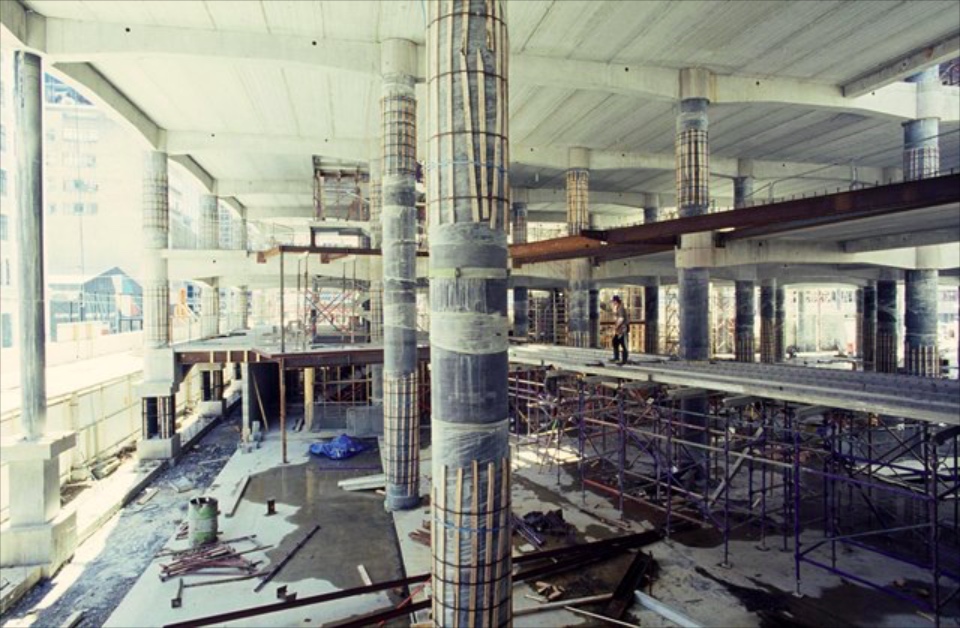
That means that there is a large, floppy hole under water, down by the harbourside. Never a good thing to have: asking for trouble. So the problem with the Library is not just a problem with the Library – it is a problem with the whole Civic Square, potentially able to fall into a giant underground underwater hole. Not quite as dramatic as that of course – more that the hole is held up by elements that can rack and move and that already leak like a sieve. Any work in this region probably means that the whole hole needs to be wholly dug out and rethought, before being rebuilt and reoccupied.

There is also a problem with the planning, putting it bluntly. Let’s be honest: the entry into the Library was always a bit of a mess, with the cross-over between east-west traffic to Clarke’s Cafe and the Civic Square clashing wholesale with the entry to the Library itself. It worked, kinda, but only sorta. The escalators were poorly planned out, the offices above never really worked. The entry portico was demolished a few years ago due to being an earthquake hazard, so the connection from one side to another was lost. The lifts from the basement up to the offices above and the aerial walkways in and around the entry – it was ground-breaking and innovative at the time, but it was a bit of a dog of a solution in reality. Structurally it was probably a nightmare as well, creating a large void in the centre, where normally a core might be a stronger element, not a weaker one. I’d like to put down in writing the possibility, that despite Saint Athfield’s unimpeachable sense of design fun outside, the truth is that the Library needed an enema to clean out all the crap on the inside.
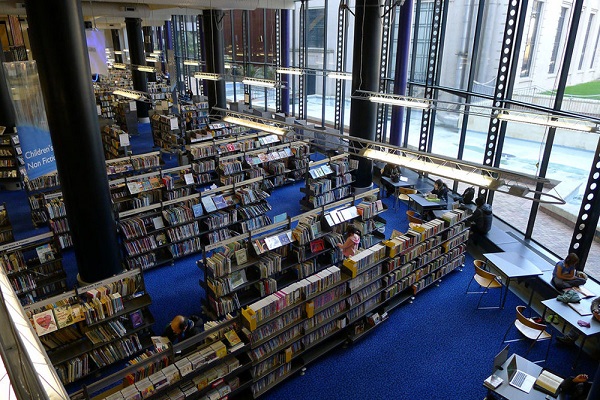
There is a bigger problem that the loudly clamouring few are not acknowledging: that our younger generations are not using Libraries. Being a book-lover myself I didn’t want to believe this but it is sadly, massively true: the actual use of Libraries as places to borrow books has suffered massive decline over the past ten years. Just as newspapers and magazines are closing through loss of custom and loss of advertising income, Libraries are also closing down all over the “developed” world due to lending rates tanking. Of one report I saw, a major Library in NZ had seen its borrowing rate go from 200,000 books a year down to 50,000 loans a year, over the last five years only.

That’s an almost direct line straight down to the bottom. It will level out of course – there are still older people alive who will keep on taking out books – but even they cannot stop the inevitable. Book-loaning habits have changed considerably and are changing still. Twenty years ago when I lived in London the Tube and the trains would be packed with people sitting reading newspapers – last time I was there a couple of years ago there wasn’t a newspaper to be seen. Every single person was sitting reading a screen. No longer could I look over the shoulder of someone to read the other side of their paper. Newspapers are dead: they just don’t know it yet. Stuff, for instance, has just been sold for ONE dollar – presumably that includes all the papers that contribute to it as well – so that puts the price of the Dom Post at about 30 cents… Libraries are also dead: like Zombies, they still keep on plodding along, mumbling and muttering about overdue books and borrowing rates, when in truth, the Library lending model that we have had for the last two hundred years is over. Finished. Kaput. Dead as a Dodo, a Moa, or a Stephen’s Island wren.

People don’t get books out of the Library like they used to – Shirley, Sally, Jo, Meredith, Barbara, Trish, Bev, Wendy, Adrina, Marion and Peggy (see a trend forming here?) – yes, YOU may still use a Library that way, and good on you to (so do I), but fewer and fewer other people do. Over on Scoop, Sally says: “Where in the world would you find a capital city without a Central Library. The present library needs to be strengthened – that’s it! Now just get on with it. The length of time and deflection to considering hubs or a different location is truly outrageous. I want priority given to fix the present central library and return it the people asap please.” But it is possible that Sally has not been doing her homework. All over the world, Libraries are changing and book-loaning habits are getting less and less. Yes, major cities are still mainly have Libraries, but they are not the same as they once were. Research, once the prime reason for specialist libraries, is more and more becoming an exclusively on-line thing. I do a lot of research by looking through on-line indexes of journals and articles, without leaving my chair at Eye of the Fish Towers, and I search newspapers from the National Library by using Papers Past, not by physically delving into a stack of yellowing newsprint.

The Library is, of course, so much more than just a place to get a book out, or to read a magazine article in the sunshine, overlooking a bustling Civic Square while gently snoozing over your lunch. The new, much-vaunted TÅ«ranga – the new Architectus / Schmidt Hammer Lassen / Ngai Tahu designed Library in Christchurch (disclaimer: I’ve not yet been there) was evidently very-much liked by young Lester the Jester, but that is primarily because of things it did that were not book related: game playing, children caring, fun finding, music listening, activity organising, and more: an entertainment centre rather than a site for learned learning. And that’s all good for what it does – but c’est n’est pas une bibliotec. The one review I have read by an actual grown-up human was totally horrified at the lack of actual books: the New Zealand Fiction section was apparently on the bottom shelf of the top floor, with one of each: one Maurice Gee, one Ronald Hugh Morrison, one Margaret Mahey, etc. Is that what the Librarians want? Who cares. Is it what the public wants? Presumably so.
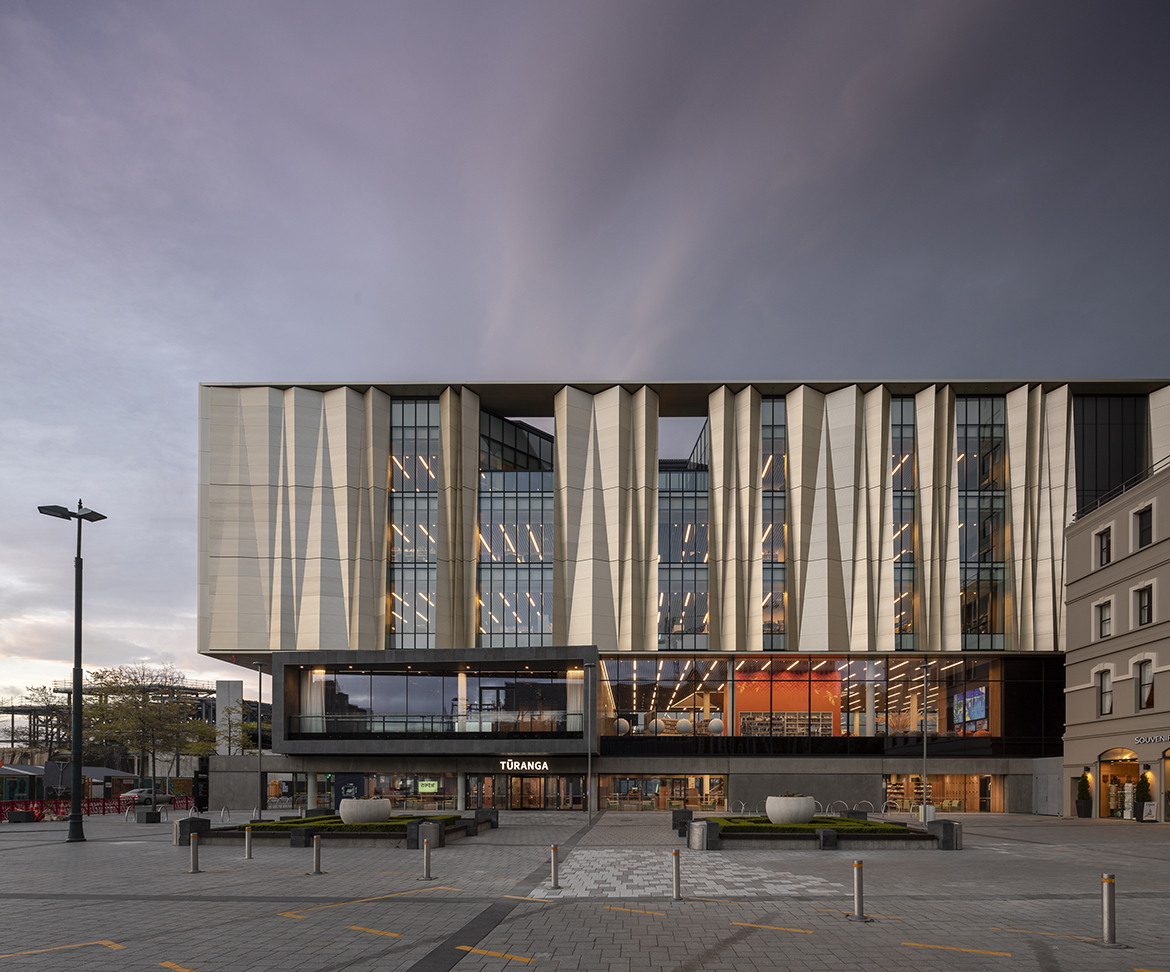
Lead architect Carsten Auer has said: “Libraries have moved on from being repositories of books to being multi-media hubs and social hubs. The modern library is the ‘third space’ between home and work. It’s a place where you can meet people or be ‘alone together,’ enjoying sharing a social and recreational space with others, even if you are not engaging directly with them.” I think that if the above-mentioned Shirley, Sally, Jo, Meredith, Barbara, Trish, Bev, Wendy, Adrina, Marion and Peggy were to go down there and visit, they may possibly be disappointed that books are not to the forefront. It’s a new concept, for a new time. But it is not a Library like the one we used to have.
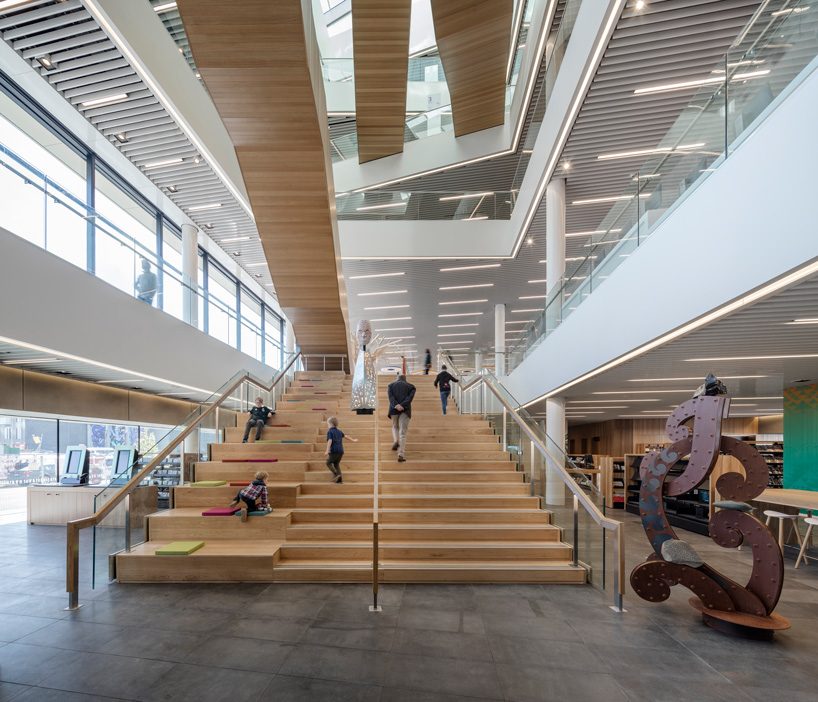
So: new function, definitely. Does that also mean a new building? C’est possible. Certainly, before the 2016 earthquakes struck and caused realisation of the issues that have cancelled our civic centre, the librarians were hard at work with architects on a potential massive redesign of the interior. My recollection is that this was a proposed $25 million refit of the building and its contents. My wish is that this had been shared with the public, at whatever stage this got to. On top of this now sits a need for massive amounts of strengthening, taking the bill up to a rumoured $100 million or more. The question surely has to be asked, as well, is it worth it? My further wish is that the WCC fully embrace the openness and further share things with us all – we pay the rates that pay the wages and pay the bills. You, the WCC, work for US, the people, not the other way round, so yes we do indeed demand to see the Engineer’s report, pronto. Mayor Andy Foster, please note: hiding the report for another ten days helps nobody.
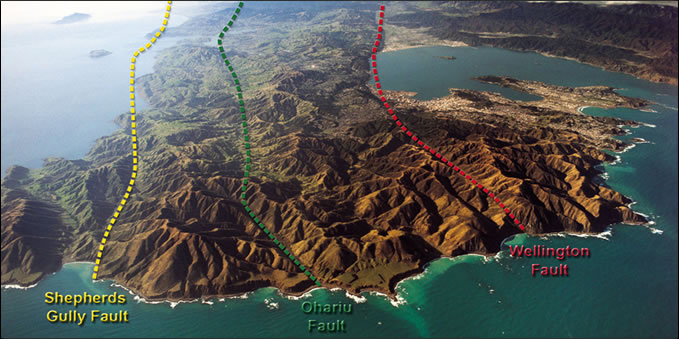
And finally but definitely not a small question to ask or to answer: is the building in the right place, not just horizontally, but vertically as well. We know our city is ridiculously badly sited, bang smack on top of the biggest baddest fault line of all time, poised atop the junction between the Pacific Plate and the Australian Plate, that has gone off repeatedly in the past and will undoubtedly do so again. The Wellington Fault runs right through Wellington, and the Library is sited on reclaimed land that is composed of mud from the sea floor and layers of town rubble, an unstable mess that no-one in their right mind would want to build on really. A bowl of jelly that wobbles when we stick our spoon into it. A jelly-tip without the chocolate icing. A Pacific Island with a capital poised on the edge of the rising sea, with the Library being a few centimetres below everywhere else on the CBD – the low point of something that is not terribly high in the first place. The question has been asked: how do we protect ourselves against rising sea levels? Well, quite possibly not by situating our main Library right on the water’s edge, next to a rising sea, on unstable ground and without base isolation, over a leaking basement and a crumbling structure, even if it does have a very cute facade composed of zinc and copper Nikau palm trees. Personally I am all in favour of a period of Public Consultation.

27 May Post-script – after the WCC meeting with significant public discussion about the Central Library. The following are some snippets I managed to note down during the meeting:
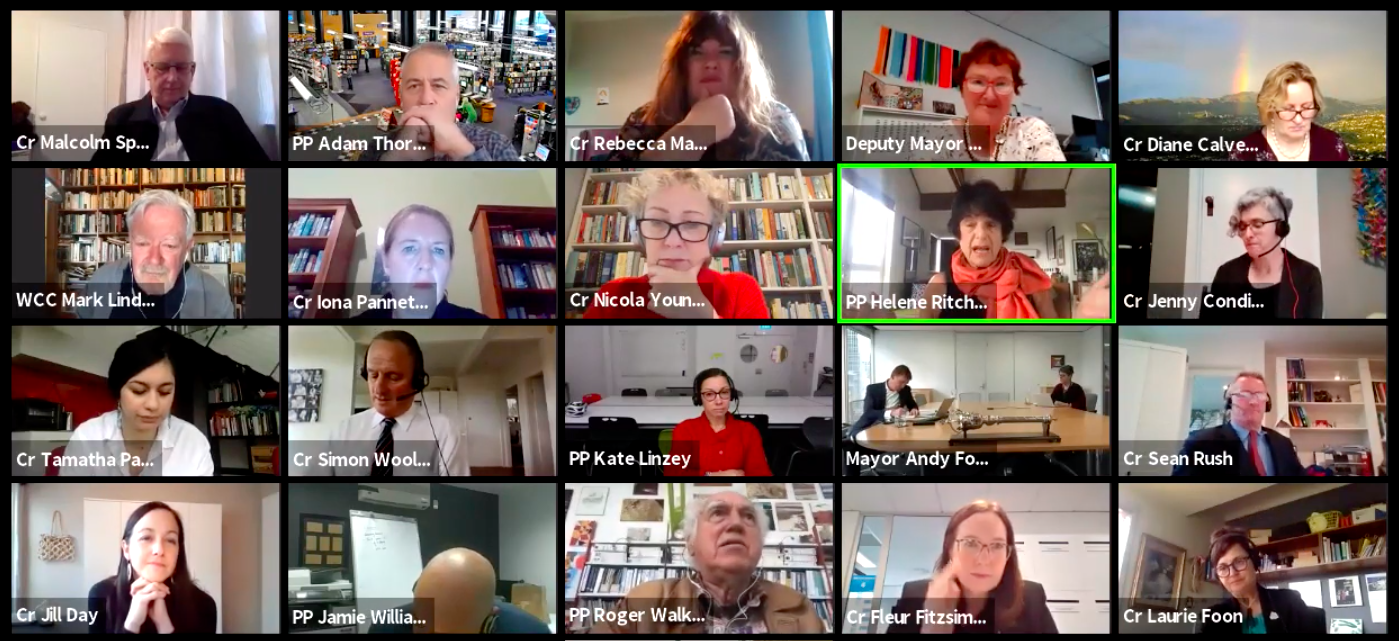
The WCC public meeting started off with a healthy amount of public participation – most of it quite sane and rational, which is a pleasant change. Evidently discussion about the Library brings out the best, not the nutters (mostly). Helene Ritchie, former deputy Mayor, argued strongly for doing the bare minimum of remediation and also demanded immediate action – decisions to be made within a week. She boldly stated that the Library CANNOT be demolished, as it is in a Heritage area.
Scoop Wellington’s Lindsay Shelton spoke next – forensically picking apart the Council’s report, paragraph by paragraph, noting that while the Library was mentioned, it was only briefly referred to in paragraphed 55, then 63, and then 93. Thanks Lindsay – I’ll skip the rest then! Lindsay Shelton noted that “what was disgracefully absent was any recommendation that the Councillors should note the ENORMOUS public concerns around the Library” and instead the Council Report merely notes demurely that “community interest has been high”.
Roger Walker spoke and referred to the Poetic aspects of Ian Athfield’s design – “a building is not just a structure with a roof” – the Library has poetry and joy and there is a feeling of joy to be there. Roger Walker is always a persuasive speaker, and he notes that his old mate Ath was one of only two architects to have been knighted and that the building is in a Category 1 Heritage precinct.
The Architectural Centre president spoke next – Kate Lindsay – and she was great – short and sweet. She noted that the building was ground-breaking at the time it was built and it is quite playful – it is a fun building. The Library is what you may term a “decorated shed” (in a reference to Venturi there that may well have gone clean over the heads of the assembled Councillors) but she also noted that this would enable the building to have plenty of scope to adapt into what we need for the future. Good point. Kate Lindsay argued forcefully that the building supported a significant diversity of people within and that it is an essential service and facility – “a living room for the people”. She stressed that Wellington NEEEDS a Library and that the Council could do a partial strengthen now if needed, but the City CANNOT have 10 years with no Library. We need a solution to reopen now.
The last person I took notes on was Adam Thornton, on his own, but formerly the leadership at Dunning Thornton Consultants. He is a pretty clued up engineer about strengthening work, so his word obviously carries a fair amount of sway. He noted that: it was obvious at the NZIA-organised public meeting about 10 months ago that there was significant public desire to retain and strengthen the building. He has reviewed the Council’s strengthening concepts and notes that they are sound, but conservative. He notes that “Significant savings could be made” – for instance a 20% contingency has been applied and the fit out has been included – so that the real strengthening costs are significantly less. The allowances for building services are “extremely generous” – and that generally, the contractors and consultants that he had spoken to all agreed that the cost estimates were significantly greater than what they would think was appropriate.
Most importantly when Adam Thornton was pressed on the possible timelines to get things done, he was concise: a year for the design, 3 months for procurement, and 2-3 years max to provide a base isolated building that would be a robust enough design to survive a 500-1000 year earthquake with little damage.





Levi, have you been out to the new Johnsonville Library? (now part of the Waitohi hub)
It still has numerous books, but also meeting rooms, and a technology room including sewing machines, over-lockers, 3D printers (and the computers with software to enable them), and other creative bits & bobs.
Wellington Libraries had already started transitioning to non-tree based reading formats. They allow digital checking out of movies, as well as books on e-readers. They aren’t starting from a low base point for this.
That aside, yes – just what the heck do we do with the ‘hard’ Wellington Library infrastructure? =/
If you’re not aware of it already, I’d highly recommend the excellent podcast 99% Invisible, about design in various forms. They’ve done an episode on where libraries are going/have gone called “Palaces for the People”.
I’ve never understood the hero-worship of Athfield when his buildings seem to often have serious flaws in building flow, form and weathertightness. I assume all my lecturers at uni were of the generation where he represented the new and exciting, so could overlook trivial things like not leaking.
While some parts of the library are quite nice (like the windows facing away from the busy street), I’d be leaning towards starting again with a new brief that describes a multi-functional building, engaging with the square, anchoring the civic centre of the city. We’re trying to grow the population in the central city and people will need somewhere to go when they need to escape their 40m2 apartment.
I feel that this is going to become a bit of a debacle, and whatever is chosen will still displease a lot of people.
I remember a few years back walking through the basement carpark for the neighbouring civic square buildings and a lot of water was pouring through the concrete. Even back then, I assume that was a weather tightness issue at high tide?
The way I see it, the main question we need to ask, other than what function a modern library should perform, is how we expect the building to behave during and after a significant earthquake. I haven’t read the engineer’s report yet, but I imagine the options are something like this: –
Option A – Do nothing – Building is very flexible, and hollowcore floor units have insufficient seating so may lose support, causing significant risk to anyone in building. Requires demolition after.
Option B – Minimal strengthening – At this level of strengthening you are essentially trying to protect anyone in the building by catching falling floor units on brackets and sorting out a few other critical issues with the concrete frame. The building is not exactly useable afterwards and I imagine would still require demolition.
Option C – Base isolation – Bloody expensive, probably due to requiring piling within the basement. Building can serve a post-earthquake function with some repairs.
Option D – Demo and new build – Would be designed to be operational after a major earthquake.
What do the public and WCC expect? I’m not sure, but I imagine the library would be a good space to use for civil defence purposes after a major quake.
Seamonkey – No, haven’t been there yet. Was meant to go before lockdown – I presume it is reopened now?
Andrew – thanks, I’ll check that out. Yes – can’t remember if I mentioned it above, but the Library were already planning to do a major ($25m) internal refurb on the building, making it much as you say: a multi-functional building.
Tui – great comments, thanks. Again, I’m not an expert in this, but i think that the way the Base Isolation would happen would be that they would have to cut each column in two places with a diamond-wire to slice out a 1m section for the base isolator. They’d then have to jack up the floor locally, just by a couple of millimetres, so they could slide in the new base isolator, and then lower the floor back down, and lastly, I’d guess that they might have to reinforce the stub of the column below the base isolator. Repeat for all 96 columns. Then they would have to (actually, probably they would have to do this before) cut a 600 ice trench around the entire outside fo the building, to create a seismic moat. Any extra piling would be separate to all that.
Bunjil Place in Melbourne is also an example of the ‘new-wave’ libraries.
And it looks fucking sexy to boot!
https://tothotornot.com/bunjil-place/
It does indeed ! That timber work is amazing! How come I didn’t know about this? I’m slipping !
A couple of other ‘new-wave’ to have a virtual peep at: Perth library (Kerry Hill Architects 2016) a bit splendid. Has books!
https://www.abc.net.au/news/2016-03-02/city-of-perth-library-finally-opens/7214686
Seems to be a circular thing going on in Oz: the Darling Square Library (Kenga Kumo 2019) also round. Bonus for users? It sits on top of a food hall :)
https://concreteplayground.com/sydney/design-style/darling-square-library
Excellent post, thank you. The level of evangelism on that site about a) libraries b) Athfield’s design is quite strange. Good luck to anybody who thinks otherwise though as the admin either disallows comments or edits them if they are anti-library. I had to laugh at one of the quotes from a councillor on there about why he thinks the library is great – he enjoys reading Jack Reacher books he gets out from there. Goodo – use a Kindle mate and let’s build a better space for half as much money as re-doing the old one? The other irony of course being that it sounds like these people want more consultations to remove a few parking spaces than they do to spend $200m on a library but oh well.
On newspapers you are also right, but you will be glad to know that in London you can still pick up a free paper on the seat or read over someone’s shoulder – I think between them the Metro & Evening Standard still pump out 2 million copies a day (though whether they will continue to do so when restrictions after lifted is another question – I wouldn’t know as I’ve not been on a train for nearly three months now!)
I have read your article and am confused as to whether you are supporting the strengthening concept or putting forward a treatise that libraries and books are now to be consigned to history as no longer being pertinent to society. Your article does not really make sense unless you are considering yourself as influencing the direction that society should go. Other contributors have already found errors in your argument and this undermines the whole article.
I’m going to turn to the liberal cliche of “but look at is doing”. Helsinki just opened a pretty badass new library
https://www.archdaily.com/907675/oodi-helsinki-central-library-ala-architects
And for bonus liberal points, a Guardian article about Finland’s approach to libraries
https://www.theguardian.com/cities/2018/may/15/why-finlands-cities-are-havens-for-library-lovers-oodi-helsinki
Thanks JW and thanks also John. – I’m not trying to make a stance, i’m merely presenting the facts that I think are pertinent to the case. I want everyone else to make up their own minds, not have me “influencing the direction that society should go”. As always, I’m the first to proclaim that I’m not perfect and I make mistakes, and so that is what this blog is about – a place to discuss and present differing viewpoints.
Clearly many people in Wellington really like / love the Athfield building, and will blindly proclaim that it “must be saved” but they are not considering or do not know about all the other aspects. What I am saying is:
• Libraries are changing, fast, and ours has not changed yet…
• It’s not a perfect design
• It’s not a perfect construction
• But it is ours, so if we want to keep it, we need to be really really sure about it, as it will cost us a lot of money. We need to be 100% behind whatever we propose.
But also clearly (to me anyway) there are many many more people who are not jumping up and down about it and they may either love it – or hate it. We need to get their views as much as other people’s.
And thank you too to Grant and Joseph – excellent references, thank you. I’ll go check them out – well, virtually, of course. I’ll not be flying to Perth or Helsinki for a few years yet methinks…..
It’s interesting to see architects so confident in forecasting the future of libraries. I wonder how they would react to a bunch of librarians telling them how to design buildings to make best use of the Building Act.
Anyway, to the matter at hand. There is considerable merit in the argument that cities need substantial central libraries – forget about Helsinki, even Hamilton and Tauranga have them. The current site seems well suited and well supported. Why not initiate a quick and dirty design competition where retention in part or whole is an option alongside a tabula rasa? Perhaps the die-hard lovers of the current building would reconsider when faced with actual alternatives.
If, as you state, you are just presenting the facts in this debate, it would be wise for you to have a care with the language you use. Your comments about women, and asserting – as you do above – that people “blindly” make proclamations about the Athfield building, come across as sneering and dismissive.
I hope that you listened to the submissions to Council in their Zoom meeting yesterday.
A family member has experience in the areas of seismic risk and earthquake strengthening, and has been through the information released by Council. It’s very clear that only one element – the floors – has been identified as being at risk in an earthquake. The aspects of the floors which are problematic, are the “pig-tails” and the seating. The floors can be remediated relatively cheaply and simply; once that’s done, the library can be reopened. Base isolators will further improve the resilience of the building, and these can be fitted later, as funds become available. Adam Thornton pointed this out last year, and again at yesterday’s meeting. Which you’ll know, if you were watching. Roger Walker also spoke yesterday; he made points that were similar to those made by Thornton.
In the course of yesterday’s meeting, the point was made that the Civic Square is a heritage precinct, and therefore worth preserving in its entirety. Talk of the library’s demolition bespeaks an utter failure to recognise its significance in that streetscape.
I am old enough to remember Wellington as it was before Civic Square was established; when the library was in the City Gallery. I can assure you that Wellington with Civic Square and its associated buildings and structures is orders of magnitude better than what preceded it.
Margaret – Just a quick note on your family member’s comments about the floors. The “pig-tail” detail you refer to is for double tee flooring, such as what collapsed in the Statistics Building. The library has hollowcore flooring, which has other numerous issues, but mainly seating (as you mentioned).
Rather than a remediation, the cheap solution is more of a catch bracket for when it drops and that’s why the building would need to still be demolished with just this solution, after a serious earthquake.
I agree that a two stage retrofit would be the way to go though, as long as we don’t waste money on removing and reinstalling the fitout/services twice.
If anyone is interested in a technical presentation on why NZ precast flooring is such an issue, this presentation by Des Bull is quite good. There are actually some pictures of the library used as examples in it too (I’ll let you guess which ones).
http://concretesociety.org.nz/Downloads/2018/S1_Des%20Bull%20Presentation.pdf
Sorry to get into the boring engineering side of things, I promise I’ll make this my last engineering based post.
A hot-button topic. Here’s another point of view.
We routinely ‘save’ buildings that we deem to have some cultural or design significance. This is called heritage and the building or place need neither be ‘good’ or ‘functional’ in order to have some heritage significance. In fact, much heritage is quite inconvenient and expensive to keep, but we do it for the value ascribed to it.
While i think it is a stretch to call Civic Centre a heritage precinct (but that should be evaluated, for sure), the Library arguably has design significance in a number of areas, not least of which is the fact that it is the best PoMo major building in New Zealand. Soon we will be decrying the loss of PoMo heritage because of the flaky construction and bad taste aesthetic (I can be a little provocative!?).
The Library obviously has cultural significance as an important successful public and urban building in Wellington – the level of vehement defense of it in response to any criticism at all is proof of that.
Heritage NZ where are you in this discussion? Dropping the ball on major Wellington landmarks again or have I missed something? Need volunteers at Architectural Centre to do your job again?
Margaret – thanks for your comment – and yes, I regret to say, I took the time to watch every last second of the two and a half hour Council meeting. Much was said – little or nothing decided, and little or nothing actually done. I wonder about the point of the Council – there were several Councillors who made zero contribution and said not a word about anything – Tamatha Paul spoke well, as did Mayor Foster, but some others like Rush (“I want Rugby open by August!”) were and are a bit pointless.
My apologies – if I came across as “sneering and dismissive” – that’s just my resting bitch face. My comments are more that people who are clearly not engineers are making comments about the engineering – I’m an architect, so I have some understanding on the subject, but not enough to ever authoritatively comment on an engineer’s work, yet others do so. It is a bit like people commenting on a Doctor’s work in the surgery – “oooh, all they needed to do was sever the aortic valve and then dice the spleen – i read an article in National Geographic about that once.” What gives non-specialists the right to criticise and advise those who have spent their life training in a particular subject.
Anyway – to your assertion that the “only one element” of the building is at risk – ie the floors. Did you read the article above? Do I have to list the many problems with the building all over again? Perhaps I should:
• It has a large open plan floor frame, with a large hole in the middle. Structurally, that is a nightmare.
• It has one extremely stiff side to the building, and one wavy, completely open (glassed) side, which again makes it structurally unstable.
• It has more weight up the top and less down the bottom, which structurally is also not a good thing.
• I could go on, but I won’t, as undoubtedly you will probably just say I am again being sneering and dismissive – sorry, been a long day and I am still at work, so I’ll stop there….
Tui – certainly don’t stop commenting on Engineering matters – not boring at all – and on a subject like this, very useful!
I think your comment is very telling: “the cheap solution is more of a catch bracket for when it drops and that’s why the building would need to still be demolished with just this solution, after a serious earthquake.”
m-d – Great comment ! Especially your last line….
Tui I agree that the “catch bracket” piece of retrofitted angle iron is a small ambulance at the bottom of a hefty cliff
I’m seismic retrofitting a small commercial space at the moment with diecore/hollowcore and we have just ripped the carpet off the top, drilled through the floor topping slab to locate the cores, broken out the apex of the core next to the walls then epconned starters into the walls and filled the cores 1200 min out from the wall with 30Mpa concrete
Not much more dollars than brackets underneath – speaking of which I believe a certain building not a million miles from Molesworth St finished by a construction company that rhymes with dawkins was sold to the tenants as “fully seismically built” and yet mysteriously workers were drilling and installing angle iron brackets on nights and weekends as “maintenance”
Margaret – sorry I missed the bit where Levi was scathing towards women unless you are talking about Councillor Helene Ritchie who is well known about town as a gold-plated ocean-going full noise nutcase, as sure as Roger Walkers’ roofs leak.
Sorry, noting that Leviathans main points still stand, no core, big hole in the middle etc
m-d : heritage is such a interesting thing. I take quite a strong interest in it. With relation to the Library, there are several aspects to the Heritage of the building. There’s its public use factor, of which most people are clamouring in favour of – me too – it is such a vital facility for Wellington. Then there is the factor of being an Athfield building – of whom Wellington was his favourite playground, so to speak, but his main field of work was domestic, so there are perhaps not so many of these civic buildings by Ath. There’s no doubt that this is his finest. And then of course there is Post-Modern factor that m-d refers to : possibly, as m-d says, the best Po-Mo building in New Zealand.
Of course there are many Po-Mo buildings in New Zealand, but this is one of the few where the architect has given full speed ahead to his artistic and fantastic feelings – it is a delightful playful building with references back to early Maori and settler design with the walk through the nikau forest glade, it is a reference to the walled cities of Europe: the citadels of cities with great Libraries; it refers to Bolgna and the great colonnades across hot towns in Italy; the wavy lines of the windows and the outlook to the pools (when full) as a simile for the sea; there are so many reasons to love and cherish this building. It doesn’t, however, get away from the fact that there are also design decisions that can be viewed as structural weaknesses.
There’s a letter in the DomPost today by someone who would be most charitably described as a bit of an idiot – he’s in Karori, although that doesn’t make me a man-hater or a Karori hater – but he advocates demolishing the Library, building a new Library that is a carbon-copy of Christchurch’s Library, and building it on a “under-used field” near Te Papa ie Waitangi Park. If it is OK with you Margaret, I’m going to get all sneering and dismissive over this suggestion – the pain and hardship that Wellington went to get Waitangi Park as a feature for all, and this plonker says it is an underused field…… Sigh…. a park is a park, and heaven only knows we need more parks in the inner city, not less. Waitangi Park is a great Park, and does not need a building plonked in the middle of it.
But also, the Library does not need to be at the other end of town. It really does need to be in the Civic heart of the city (if only the Council would come back!!) – and really it already has a logical home and an existing excellent building, albeit with some massive structural issues that urgently need sorting.
When I look back at what purpose-built libraries looked like decades ago, and how they worked way back then, they sure have evolved, grown, and changed significantly over that time.
They used to have a very limited utility – somewhere to go and get take-away books, or to amuse yourself by reading the provincial press, or to do homework/study, or to look stuff up to settle an argument.
Now they do a whole bunch of other stuff as well.
So whatever happens with the “fixed†Wellington Central Library has to include the books, and the whole bunch of different stuff that currently happens, and a whole bunch of new and evolving different stuff that hasn’t started happening yet.
If there’s going to be more demand for more things, then I doubt that simply fixing the existing issues with the existing building is going to be enough. There’s going to have to be some other building somewhere. Possibly for the books, possibly for some of the other stuff.
However, it’s a neat-looking building – I see it as a definite visual asset to the city – and I reckon that at the very least the outer shell should be preserved – if only as a reminder of the days when the City of Wellington used to be able to do things.
As for the how, I will quite happily leave that to the engineers, architects, librarians, and associated trades.
But they do need a much better brief than simply “Make it like it wasâ€
Mr Henry Filth – absolutely right. Couldn’t have said it better. “they do need a much better brief than simply “Make it like it was—
And actually, that is what the process was that they were already doing, before the Town Clerk closed down the Library. There was a massive redesign / upgrade process already going on, with a proposed budget of $25million, for completely revamping the budget. I think the head Librarian and maybe also Athfield’s spoke about this last year. Not 100% sure, but i believe this cost was bundled into the non-existent Elwood Report.
Little was said as to what the $25m ‘revamp’ was actually going to be at the time (it was never publicly released) but THIS came out after the library was closed. As far as I can tell, it had little to do with revamping the actual ‘library’ bit of the library and more to do with providing council chambers, offices for councilors and a fancy mayoral suite for his / her worship. The council chambers and mayor’s office in the Town Hall had to close for the restrengthening work going on there and the councilors’ offices in the old council building were also subsequently closed. Their proposed solution seemed to be to take over about half the 2nd floor of the library (not sure where the librarians or the entire NZ Reference collections were supposed to go; they were already jammed in like sardines) + the 3rd floor which were separate council offices and never occupied by the library itself. This doesn’t look like anything that would actually improve library services but more like the mayor and councilors shafting the library, taking over its space and using it to give themselves flash offices and meeting spaces.
https://www.stuff.co.nz/dominion-post/news/wellington/115211862/wellington-mayor-and-councillors-abandoned-library-move-due-to-uncertainty
Thanks for that John (v2) – very interesting. Who knows quite where the truth lies! I’m basing the $25m figure off a comment at the public meeting last year, when a senior person in the Library (my apologies – i cannot recall her name) mentioned that figure and the implication was that they were already planning library changes. But you could be totally right – and perhaps they were just discussing some more squashing to squeeze more people in, and more books out.
That seems to be the part that the people over on Scoop don’t seem to get – libraries are de-stocking their shelves at a huge rate, in NZ, in Wellington, and generally all over the world. Not since Kristallnacht have wee seen such an effective book burning. I have a friend who makes a habit of stopping by his local library back yard, where there is a skip – books get de-listed, de-catalogued, de-shelved, de-fenestrated, every day.
Is this a good time to remind everyone about the grisly fate of the Auckland School of Architecture library?
Levi; if it was the meeting at the National Library that the NZIA organised then the person in question was not from the central library but City Councillor Iona Pannett who confirmed the amount of $25m when she briefly conferred with fellow councillor Sarah Free who was also in the audience. I distinctly remember this as a librarian who was sitting directly behind me let out the f-word when she heard the amount and exclaimed that neither she or anyone else working in the central library knew anything about the proposal. As shown by the plans in that Stuff article, this was evidently because it was primarily about getting nice digs for the councillors and the mayor, not about improving the library space itself. In the end I guess it doesn’t matter as the pre-cast floor panel issue put the kybosh on the whole idea a few months later anyway.
John 2 – How very odd. You must be right – my memory is clearly wrong.
Starkive – the latest issue of Arch NZ (still surviving) has a review of the new Engineering tower which almost abuts the existing Architecture Library up there in Auckland. I’m not 100% sure whether it has been demolished yet, but it has certainly been defrocked and debooked, if not defenestrated. Auckland’s School of Architecture is a lost cause – the leadership of the University is toxic to me. It makes me very sad indeed.